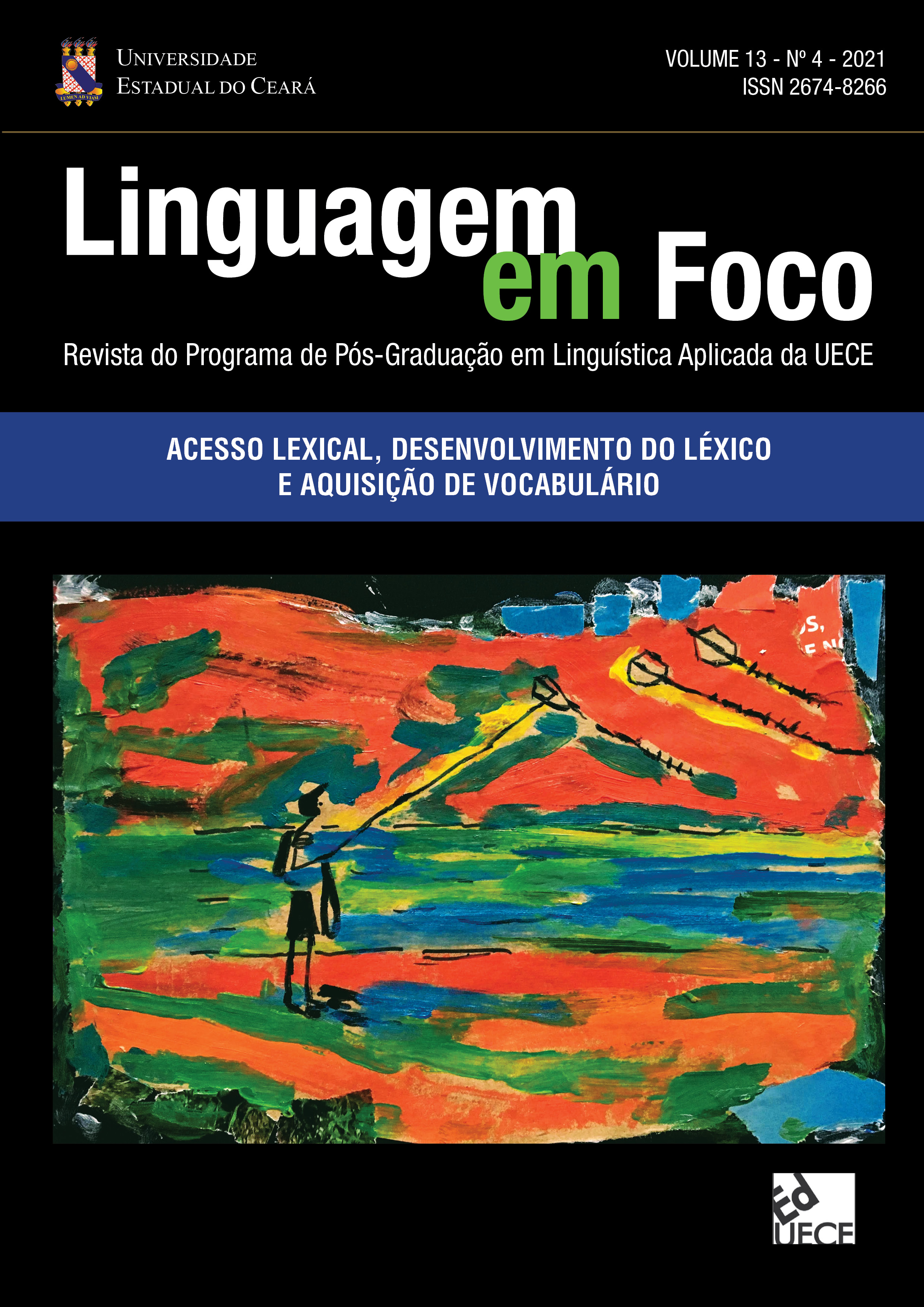Lexical Access in Reading
Lexical Access in Reading: synthesis of results from eye-tracking studies and its implications for literacy
DOI:
https://doi.org/10.46230/2674-8266-13-7433Keywords:
Reading, Visual word recognition, Eye Tracker, Dual Route Cascade Model, Iterative Model of the Perceptual ProcessAbstract
This article aims to present the word visual recognition and lexical access in reading by both describing the steps of this process and integrating it into the knowledge resulting from the studies of Cognitive Psychology (models explaining the word reading processing) as well as from Psycholinguistics (evaluating the linguistics variables which affect lexical processing) focusing on the results obtained by the eye-tracking technology. The steps of the visual information recognition (orthographic processing), and the access to the phonological, morphological, and semantic levels of the word processing, are synthesized and discussed. This synthesis, comprising examples and graphic schemata, is intended to facilitate the access of this information to educators working with literacy. It also shows the skilled readers' cognitive processes to recognize and pronounce the words individually. It starts by outlining the work of the eyes during the reading process, focusing on the words of a sentence, and their relation to eye movements covering the written material, besides specifying how eye-trackers register the oculomotor movements. Next, it describes the sublexical and lexical processes of word processing, presenting two theoretical models (Dual Route Cascade and Iterative Model of the perceptual process) until the word is integrated into the sentence and the discourse.
Downloads
References
ANDREWS, S. e REICHLE, E. The Cognitive Archtecture of Reading: The Organization of na Acquired Skill. In: (Orgs.). Hagoort, P., Beckmann, C., Fisher, S., Kidd, E., Levinson, S. Human language: From genes and brains to behavior. Cambridge, MA: The MIT Press, 2019, p. 51-66.
ANDREWS, S. e VELDRE, A. What is the most plausible account of para foveal processing in reading? Language Linguist Compass. V. 13, 2019, p. 1-25.
ANDREWS, S. Individual differences in skilled visual recognition and reading. The role of lexical quality. In: Adelman, J. (Org.). Visual word recognition: Meaning and context, individuals and development. Psychology Press, 2012, p. 151–172.
ANDREWS, S.; VELDRE, A.; Clarke, I. Measuring Lexical Quality: The Role of Spelling Ability. Behavior Research Methods, 2020.
Ashby, J. e Clifton, C., Jr. The prosodic property of lexical stress affects eye movements during silent reading. Cognition, 96, 2005, p. 89-100.
BAGNO, M. Dramática da língua portuguesa. Tradição Gramatical, Mídia e Exclusão Social. São Paulo: Edições Loyola. 2005.
Caravolas, M. e Samara, A. Learning to Read and Spell Words in Different Writing Systems. In: POLLATSSEK, A. e TREIMAN, R. (Orgs). Oxford Handbook of Reading. Oxford: Oxford University Press. 2015, p. 323-343.
Chomsky, N. Language and Mind. New York, NY: Harcourt Brace Jovanovich, 1972.
Coltheart, M., Rastle, K., Perry, C., Langdon, R., & Ziegler, J. DRC: A dual route cascaded model of visual word recognition and reading aloud. Psychological Review, v. 108, n. 1, 2001, p. 204–256.
COLTHEART. M., DAVELAAR. E., JONASSON, J., BESNER, D. Access to the Internal Lexicon. In S. Dornic (Org.), Attention and performance VI. Hillsdale, N.J: Lawrence Erlbaum, 1977.
CORTESE, M. e BALOTA, D. Visual Word Recognition in Skilled Adult Readers. In: Spivey, M., McRae, K., Joanisse, M. (Orgs). The Cambridge Handbook of Psycholinguistics. Cambridge: Cambridge University Press, 2012, p. 159-185.
DAWSON, N., RASTLE, K., RICKETTS, J. Finding the man amongst many: A developmental perspective on mechanisms of morphological decomposition. Cognition. v. 211, p. 1-15, 2021. Disponível em https://www.sciencedirect.com/science/article/pii/ S001002772100024X?via%3Dihub. Acesso em 30 nov. 21.
DICASDAMAIA. Disponível em https://dicasdamaia.com.br/2018/03/05/homonimos-perfeitos/<. Acesso em 31 jan. 22.
DICIONÁRIO MERRIAM-WEBSTER ONLINE. Disponível em https://www.merriam-webster.com/. Acesso em 21 jan. 22.
DIJKSTRA, T. et al. Multilink: a computational model for bilingual word recognition and word translation. Bilingualism: Language and Cognition. V. 22, n. 4, 2019, p. 657-679.
DUBOIS, D. et al. Lexical access and vocabulary development in very young bilinguals. The international journal of bilingualism. v. 17, n. 1, p. 57-70, 2021. Disponível em https:// doi.org/10.1177/ 1367006911431198. Acesso em 30 nov. 21.
Foster, R. “Eye-tracking in psycholinguistic research.” DELTA. vol.33, n.2, 2017, 609-644. Disponível em https://doi.org/10.1590/0102-445095461720767529. Acesso em 30/NOV/21.
GOODREAD. Disponível em https://www.goodreads.com/book/show/6706905-speeches-and-letters-of-abraham-lincoln-1832-1865. Acesso em 30 nov. 21.
GOOGLE. Disponível em https://www.google.com/search?q=foveal+avascular+ zone&tbm=isch&ved=2ahUKEwjO3bj52sP1AhV3qJUCHRnjD6UQ2-cCegQIABAA&oq =foveal+zone&gs_lcp=CgNpbWcQARgAMgYIABAIEB4yBggAEAgQHjIGCAAQCBAeMgYIABAIEB4yBggAEAgQHjoHCCMQ7wMQJzoFCAAQgAQ6BAgAEEM6CwgAEIAEELEDEIMBOggIABCABBCxAzoECAAQE1DwC1jlOmCoxQFoAHAAeACAAYsBiAGSCpIBBDIuMTCYAQCgAQGqAQtnd3Mtd2l6LWltZ8ABAQ&sclient=img&ei=KBvrYc6pPPfQ1sQPmca_qAo&bih=577&biw=1229&rlz=1C1ISCS_pt-PTBR973BR973#imgrc= OtNIPIbKXmerQM. Acesso em 31 jan. 22.
HOHENSTEIN, S.; KLIEGL, R. Semantic preview benefit during reading. Journal of Experimental Psychology: Learning, Memory, and Cognition, v. 40, n. 1, p. 166-190, 2014.
HUANG, Y. Pragmatics. Nova York: Oxford University Press, 2007.
INAF. “Estudo Especial sobre Alfabetismo e Mundo do Trabalho”, 2016. Disponível em https://acaoeducativa.org.br/wp-content/uploads/2016/09 /INAFEstudosEspeciais_2016_ Letramento_e_Mundo_do_Trabalho.pdf. Acesso em 20 nov. 21.
JUST, M. e CARPENTER, P. Tsks effects on eye movements during reading. Journal of Experimental Psychology: Learning, Memory and Cognition, v. 36, 1980, p-1561-1566.
KESSLER, B. e TREIMAN.R. Writing Systems: Their Properties and Implications for Reading. In: POLLATSSEK, A. e TREIMAN, R. (Orgs). Oxford Handbook of Reading. Oxford: Oxford University Press. 2015, p.10-25.
LORANDI, A. Formas morfológicas variantes na aquisição da morfologia: evidências da sensibilidade da criança à gramática da língua. Letrônica v. 3, n. 1, 2010, p. 81-96.
MARTIN, Ethel. Saccadic suppression: A review. Psychological Bulletin, v. 81, n. 12, 1974, p. 899-917.
McCLELLAND, J. e RUMELHART, D. An interactive activation model of context effects in letter perception. Part 1. An Account of basic findings. Psychological Review, v. 88, 1981, p. 375-407.
NOBRE, A. e SALLES, J. O papel do processamento léxico-semântico em modelos de leitura. Arquivos Brasileiros de Psicologia. Rio de Janeiro. v. 66, n. 2, p. 128-142, 2014. Disponível em http://pepsic.bvsalud.org/pdf/arbp/v66n2/10.pdf. Acesso em 30 nov. 21.
O Globo. Cérebro vê palavras conhecidas como imagens. Saúde. Ciência. Disponível em https://oglobo.globo.com/saude/ciencia/cerebro-ve-palavras-conhecidas-como-imagens-15686593. Acesso em 30 nov. 21.
PERFETTI, Charles A. Lexical Quality revisited. In SEGERS, E.; VAN DEN BROEK, P. (Orgs). Developmental Perspectives in Written Language and Literacy: In Honor to Ludo Verhoeven, Amsterdam: John Benjamin Publishing Company, 2017.
PERFETTI, Charles A., Reading ability: Lexical quality to comprehension. Scientific Studies of Reading. v.11, n. 4, p. 357-383, 2007.
PERFETTI, Charles A.; HART, Leslie. (2002). The lexical quality hypothesis. In L. Verhoeven, C. Elbro & P. Reitsma (Org.) Precursors of functional literacy. Amsterdam, The Netherlands: John Benjamins Publishing, 2002, p 189-213.
POLLATSEK, A. MILLER, B. Reading and Writing. Introductory to Special Issue on Writing Article. Read Writ. V. 24, 2011. Disponível em https://link.springer.com/article/ 10.1007/s11145-010-9268-5#citeas. Acesso em 30 nov. 21.
PROVA BRASIL, Disponível em https://qedu.org.br/brasil/aprendizado. Acesso em 31 jan. 22.
Rastle, K. e Davis, M. Morphological decomposition based on the analysis of orthography. Language and Cognitive Processes, v. 23, n.7 e 8, 2008, p. 942-971.
Rastle, K. The place of morphology in learning to read in English. Cortex. Vol. 116, p. 45-54, 2019. Disponível em https://www.sciencedirect.com/science/article/pii/ S0010945218300571. Acesso em 30 nov. 21.
Rastle, K. Visual Word Recognition. In: Hickok,G. e Small, S. (Orgs.) Neurobiology of Language. Londres: Academic Press, 2016, p. 255-264.
Rastle, K. Visual Word Recognition. In: Rueschemeyer e Gaskell (Org.) The Oxford Handbook of Psycholinguistics. 2a. ed. Oxford: Oxford University Press. 2007, p. 71-87.
Rastle, K., Davis, M., New, B. The broth in my brother’s brothel: Morpho-orthographic segmentation in visual word recognition. Psychonomic Bulletin & Review, v.11, n. 6, 2004, p. 1090-1098.
Rayner, K. Eye movements and perceptual span in beginning and skilled readers. Journal of Experimental Child Psychology. v. 41, 1986, p. 211–236.
Rayner, K. The gaze-contingent moving window in reading: Development and review. Visual. Cognition, v. 22, 2014, p. 242–258.
RAYNER, Keith. Eye movements in reading and information processing: 20 years of research. Psychological Bulletin, v.124, n. 1, 1998, p. 372-422.
SCHERRE, M. Contra-Capa. In: BAGNO, M. Dramática da língua portuguesa. Tradição Gramatical, Mídia e Exclusão Social. São Paulo: Edições Loyola, 2005.
SCHOTTER, E. e RAYNER, K. The Work of the Eyes During Reading. In: POLLATSSEK, A. e TREIMAN, R. (Orgs). Oxford Handbook of Reading. Oxford: Oxford University Press. 2015, p. 44-59.
SCHOTTER, E. Synonyms provide semantic preview benefit in English. Journal of Memory ans Language. V. 69, 2013, np. 619-633.
SCHOTTER, E., ANGELE, B., RAYNER, K. Parafoveal Processing in Reading. Attention, Perception, & Psychophysics v. 74, 2012, p. 5–35.
Taft, M. e Ardasinski, S. Obligatory decomposition in reading prefixed words. The Mental Lexicon, v.1, 2006, p. 183-199.
TAFT, M. e FORSTER, K. Lexical storage and retrievel of prefixed words. Journal of Verbal Learning and Verbal Behavior. v.14, 1975, p. 638-647.
UNESCO. Disponível em https://en.unesco.org/themes/literacy. Acesso em 31 jan. 22.
VELDRE, A. e ANDREWS, S. Lexical quality and eye movements: Individual differences in the perceptual span of skilled adult readers. The Quarterly Journal of Experimental Psychology, v. 67, n. 4, 2014, p. 703-727.
YAP, M. e BALOTA, D. Visual Word Recognition. In: POLLATSSEK, A. e TREIMAN, R. (Orgs). Oxford Handbook of Reading. Oxford: Oxford University Press. 2015, p. 26-43.
Published
How to Cite
Issue
Section
License
Copyright (c) 2022 Maria Cristina Micelli Fonseca, Katerina Lukasova, Maria Teresa Carthery-Goulart

This work is licensed under a Creative Commons Attribution 4.0 International License.
Authors who publish in Linguagem em Foco Scientific Journal agree to the following terms:
- Authors retain the copyright and grant the journal the right of first publication. The articles are simultaneously licensed under the Creative Commons Attribution License which allows sharing the work with an acknowledgement of its authorship and initial publication in this journal.
- The concepts issued in signed articles are the absolute and exclusive responsibility of their authors. Therefore, we request a Statement of Copyright, which must be submitted with the manuscript as a Supplementary Document.
- Authors are authorized to make the version of the text published in Linguagem em Foco Scientific Journal available in institutional repositories or other academic work distribution platforms (ex. ResearchGate, Academia.edu).





























